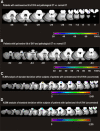A pathway in the brainstem for roll-tilt of the subjective visual vertical: evidence from a lesion-behavior mapping study
- PMID: 23100408
- PMCID: PMC6704844
- DOI: 10.1523/JNEUROSCI.0770-12.2012
A pathway in the brainstem for roll-tilt of the subjective visual vertical: evidence from a lesion-behavior mapping study
Abstract
The perceived subjective visual vertical (SVV) is an important sign of a vestibular otolith tone imbalance in the roll plane. Previous studies suggested that unilateral pontomedullary brainstem lesions cause ipsiversive roll-tilt of SVV, whereas pontomesencephalic lesions cause contraversive roll-tilts of SVV. However, previous data were of limited quality and lacked a statistical approach. We therefore tested roll-tilt of the SVV in 79 human patients with acute unilateral brainstem lesions due to stroke by applying modern statistical lesion-behavior mapping analysis. Roll-tilt of the SVV was verified to be a brainstem sign, and for the first time it was confirmed statistically that lesions of the medial longitudinal fasciculus (MLF) and the medial vestibular nucleus are associated with ipsiversive tilt of the SVV, whereas contraversive tilts are associated with lesions affecting the rostral interstitial nucleus of the MLF, the superior cerebellar peduncle, the oculomotor nucleus, and the interstitial nucleus of Cajal. Thus, these structures constitute the anatomical pathway in the brainstem for verticality perception. Present data indicate that graviceptive otolith signals present a predominant role in the multisensory system of verticality perception.
Conflict of interest statement
The authors report no financial conflicts of interest.
Figures


References
-
- Angelaki DE, Cullen KE. Vestibular system: the many facets of a multimodal sense. Annu Rev Neurosci. 2008;31:125–150. - PubMed
-
- Baier B, Dieterich M. Ocular tilt reaction: a clinical sign of cerebellar infarctions? Neurology. 2009;72:572–573. - PubMed
-
- Baier B, Bense S, Dieterich M. Are signs of ocular tilt reaction in patients with cerebellar lesions mediated by the dentate nucleus? Brain. 2008;131:1445–1454. - PubMed
-
- Baier B, Suchan J, Karnath HO, Dieterich M. Neural correlates of disturbed perception of verticality. Neurology. 2012;78:728–735. - PubMed
Publication types
MeSH terms
LinkOut - more resources
Full Text Sources
Medical
